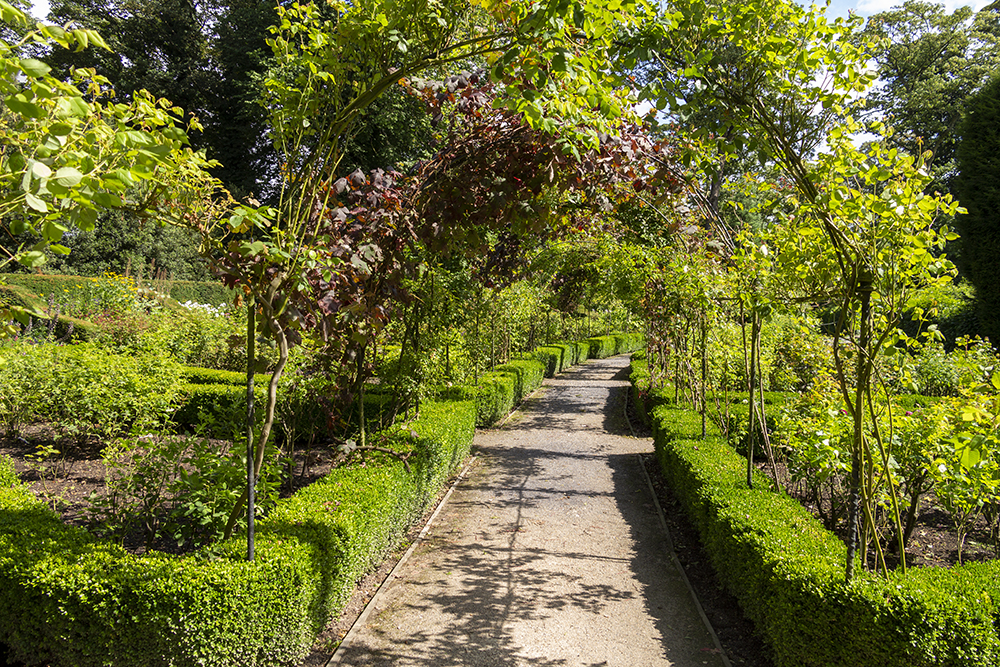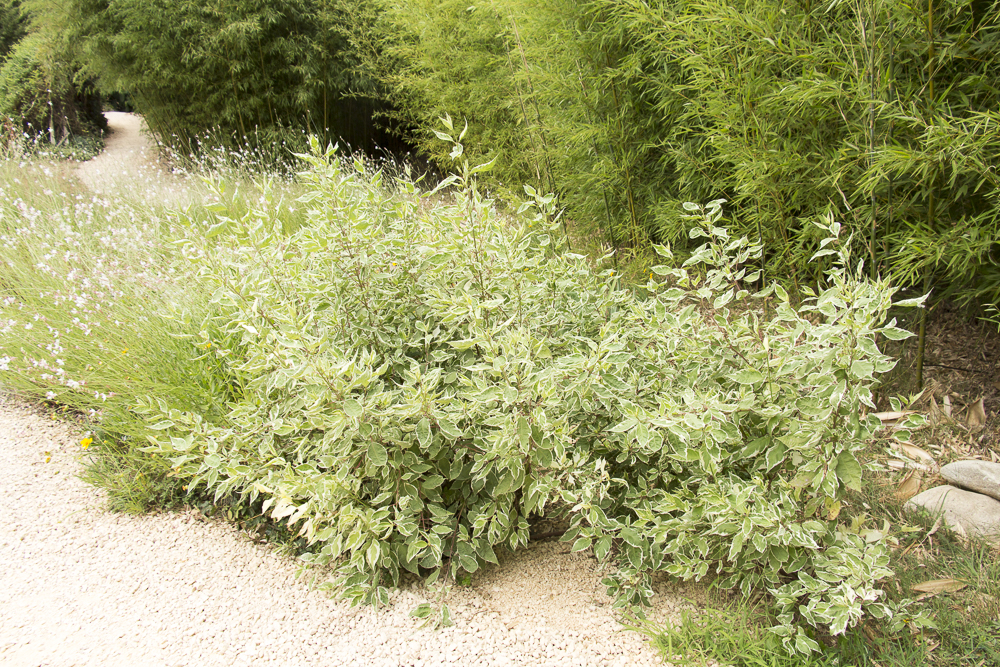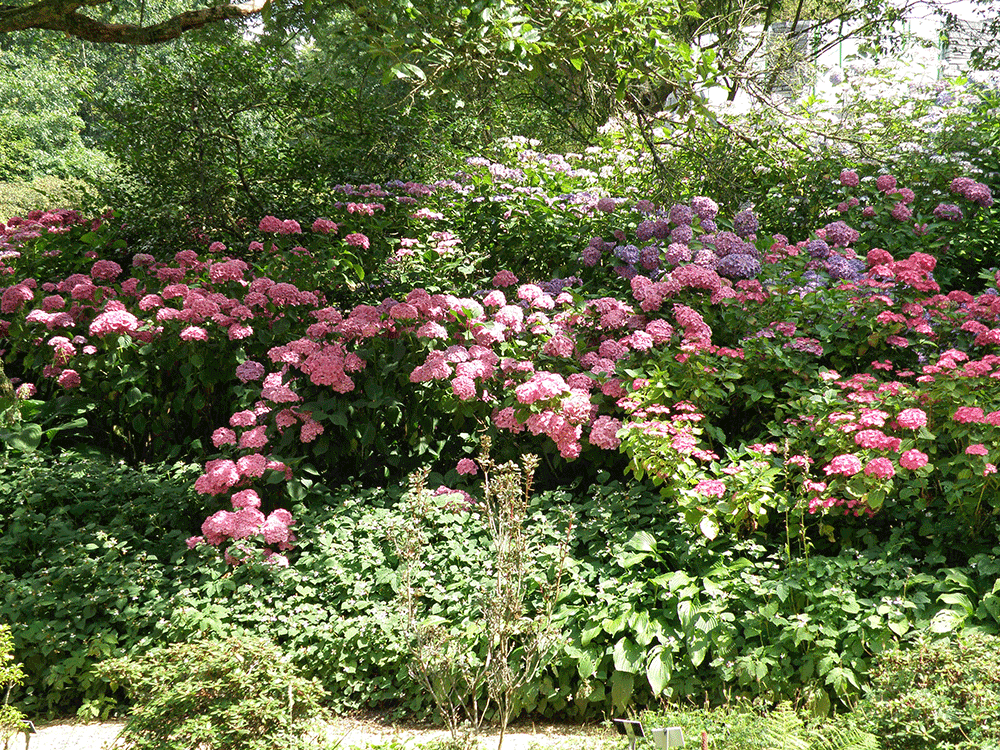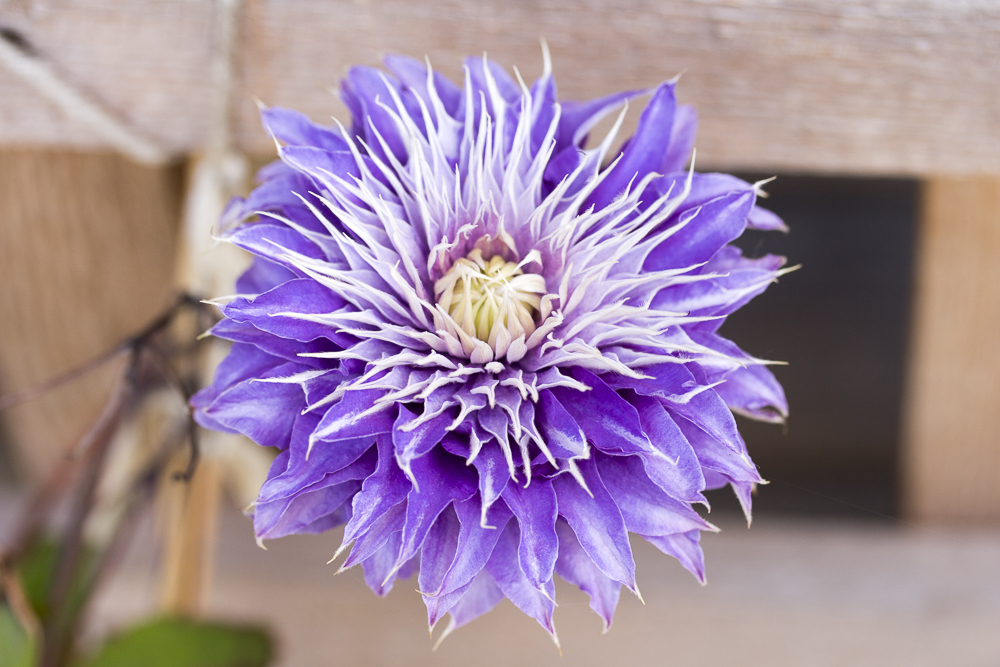Pruning plants causes a lot of heart-ache amongst gardeners and a great deal is written about how it is done, often with little thought as to why it is done. It must always be remembered that all plants are either originally wild or descended from the wild and nobody prunes plants in the wild. Before you start to prune a plant first ask yourself do you need to and if so why, what are you hoping to achieve. If in doubt, do nothing, if you do go ahead then be bold.
Reasons to prune:
- Control size – often indicating the plant is in the wrong place.
- Improve the flowering/fruiting – most fruit comes into this category, but many ornamental plants also respond to this.
- Improved foliage – can apply to the shape, size, colouring or a combination of these.
- Control disease – this can be preventative or to control a problem.
Reasons not to prune:
- Make it look “tidy”
The basic rules.
Some things really apply to all pruning:
- Remove any dead or diseased branches – while trees can survive quiet happily with large amounts of dead and even rotted wood in there core; in most cases if the branch is dead or worse still diseased it need to be removed. Any shoot with Coral Spot needs to be cut hard back as the disease will already have spread well into the living tissue below the characteristic red fruiting bodies.
- Remove crossing branches – these will end up rubbing against other ones, damage the bark and provide an entry point for disease. Also they crowd the centre of the plant, creating still air which favours pests and diseases.
- Make all cuts clearly and if back to a branching point don’t cut flush to the trunk, leave the swelling where the branch grows out of the main one.
- Don’t leave stubs – they look unsightly and are a entry point for disease.
- Bear in mind the larger the branch you cut off, the larger the wound and so the longer it will take to heal.
- Cut off large branches in stages. Large branches have a tendency to break off before they are cut though and tear off the bark below the cut. Large branches can also be very difficult to remove from the plant once cut off.
- Cut back to an outward facing bud to encourage on open branch structure.
Wound paints.
Years ago it was the norm to treat all pruning cuts with a wound paint. This fell from favour and the accepted wisdom became that all they did was seal the diseases in nice protected environment so their use has stopped. The accepted best practice is now to avoid painting anything on pruning cuts and allow the plants natural healing processes to act.
Tools.
The only tools needed are:
- Secateurs – pick a well made pair that are comfortable in your hand and keep them clean and sharp. These will do most of you pruning.
- Loppers – sometimes called parrot bills due to the shape of the cutter on some models. Used for branches too thick for secateurs but too thin for a saw. Looked after a good pair will last many years.
- Pruning saws – these come in a wide variety of shapes and sizes. Pick one that feels comfortable and replace it when it becomes blunt. Do not try to cut too thin a branch with a saw, if you can cut it with a pair of loppers use them. If you are doing a lot of pruning the battery powered reciprocating saws with a green wood blade make very good pruning saws.
- Pole loppers – these are loppers on a long, sometime telescopic pole, and they allow you to cut high branches from the ground. These come into there own when pruning fruit trees.
- Chainsaws – it will be rare, if at all, that one of these will be needed as they are for cutting large amounts of thick timber. They are expensive to both buy and maintain, as well as being very dangerous pieces of equipment. If you really think you need one make sure you are familiar with there safe operation.
Hedge cutters
These are possibly the most dangerous tool in the garden. They are designed to prune hedges, just hedges, and where there is large area of formal hedging to be kept in shape they save a lot of work. That said some of the most extensive and impressive formal hedging you will see is in formal French gardens and I have never seen a powered hedge cutter used there, just hand shears. Anything else the French view as sacrilegious. The problem is when people get into their heads that they are a pruning tool. They are not! I have sadly seen some dreadful examples of butchery as the result of a hedge cutter wheeling gardener.
Pruning table
As a general rule:
- Spring and winter flowering trees and shrubs tend to flower on the previous summer’s growth so prune immediately after they finish flowering in spring.
- Summer flowering trees and shrubs tend to flower on current summers growth so prune them in winter when the plants will not be encouraged to produce soft growth which will be susceptible to frost damage.
- Be cautious cutting into old wood as not all plants will produce new shoots from it.
- If you have to remove large branches bare in mind their cuts will take longer to heal.
- If in doubt phase drastic pruning over time.
Below is a table of some common plants with details of there specific pruning needs.
| Plant | Frequency | Timing | How |
|---|---|---|---|
| Berberis – deciduous | When too large or congested. | Can be thinned after flowering, but best pruned in February. | Thin congested branches and shorten them to a where they branch. Will generally come away from old wood. |
| Berberis – evergreen | When too large or congested. | Can be thinned after flowering, but best pruned in April. | Thin congested branches and shorten them to a where they branch. Will generally come away from old wood. |
| Buddleja davidii | Annually for best flowering. | March. | Cut back hard. |
| Clematis – large flowered hybrids which are expected to flower their main flowering before mid-June | Annually. | February to March when the buds are plump and green. | Cut out any dead wood and shorten the remaining vines to the first pair of plump buds. |
| Clematis – main flowering is after mid-June | Annually. | February to March. | Cut all the shoots to 1 metre or less above ground level. |
| Clematis – spring flowering | Only if space is limited. | Immediately after flowering. | Cut out all the shoots which have flowered. |
| Cornus – grown for their coloured winter stems | Annually, for best winter stem colour. | Early spring. | Cut back hard. |
| Cotinus | When too large or congested. | Early spring. | Cut back to within 2 or 3 buds of old wood. |
| Cotinus “Royal Purple” – if grown for large foliage | Every one or two years | Spring | Cut hard back to near ground level. |
| Deutzia | Annually for best flowering. | Immediately after flowering. | Cut out some old wood lose to the ground to encourage new growth. |
| Escallonia | Annually. | After flowering in autumn. | Cut back old flowering growths. Can be hard pruned at the same time if too large. |
| Eucalyptus gunnii – grown for its round juvenile foliage | Annually | Once frost have finished in early spring | Cut hard back to near the ground level. |
| Ficus carica (fig) – fan trained | Twice a year | End of June and November | End of June: Pinch out the growing tips of the young shoots on the frame work of branches. Tie in the resulting shoots. November: prune back half the fruited shoots to 25mm. The remining shoots should be tied in parallel to the wall, spacing them 20 to 30cm apart. Do not allow the framework to become too crowded as the young growth and fruits need plenty sunshine. |
| Forsythia | Annually. | Immediately after flowering. | Cut back flowered shoots to encourage strong new growth lower down which will provide next spring’s flowers. Aim to remove about 20% of the old wood. |
| Garrya elliptica | When it is becoming too large. | Spring | Cut back as necessary. |
| Hydrangea – climbing | Annually. | After flowering. | Cut back over long shoots but try to retain the top grow as this is where most of the flowering occurs. Drastic pruning should be done over three or four years to minimise the reduction in flowering. |
| Hydrangea – shrubby | Annually. | Late winter to early spring. | Cut one or two of the oldest shoots to the ground to promote new growth. Mopheads are best dead headed in spring to protect the terminal buds but Lacecaps can be dead headed immediately after flowering. |
| Hydrangea paniculata and H. arborescens | Annually. | Spring | For more prolific flowering prune prune back to a healthy pair of buds 25 cm above the ground level (up to 60 cm if you wish to form a taller bush). |
| Hypericum “Hidcote” | When it is becoming too large. | Winter | Shorten outermost shoots back to sides shoots to hide cuts. |
| Hypericum calycinum | When looking tired. | Winter | Can be cut down to the ground and top dressed with a general fertilizer. |
| Jasminum nudiflorum | Annually | After flowering. | Cut back to a side shoot and tie in with soft string. Neglected plants respond to being cut hard back. |
| Jasminum officinale | Annually | After flowering. | Cut back to a side shoot and tie in with soft string. Neglected plants respond to being cut hard back. |
| Lonicera – climbing and flowering later, on the current seasons growth | When it is becoming too large. | Spring. | Cut back any shoots which are becoming too long. |
| Lonicera – climbing and flower early on the previous seasons growth | Annually. | Late summer immediately after flowering. | Prune back by a third. |
| Lonicera – shrubby ones used for hedging | Three times a year. | Spring to autumn. | Trim to maintain shape. Neglected specimens can be cut hard back to 150mm high. |
| Lonicera – winter flowering | When too large or congested. | Late spring immediately after flowering. | Prune shoots flowered shoots to new growth and remove about a fifth of old wood to promote new shoots. |
| Mahonia | When too large or congested. | Once flowering is finish in spring. | They flower on the ends of shoots so shorten them to bring the flowers nearer to the ground. Come away from old wood well. |
| Malus domestica (apple): Bush – spur bearing | Annually. | November to early March. | Shorten last season’s shoots by one third. |
| Malus domestica (apple): Bush – tip bearing (e.g. ‘Blenheim Orange’, ‘Bramley’s Seedling’, ‘Discovery’, ‘Lord Lambourne’, ‘Worcester Pearmain’) | Annually. | November to early March. | Cut back a proportion of older fruited branches to a strong younger shoot positioned closer to the to the main trunk or higher up the branch. This will reduce congestion and prevent branches becoming too long. |
| Malus domestica (apple): Restricted as cordons, espaliers, etc. | Annually. | Mid to late August, when the bottom of the new shoots are stiff and woody. | New shoots are stiff and woody along their bottom third, with dark green leaves and a cluster of leaves at the base. 1. Cut back new shoots (laterals) more than 20 cm (8 in) long growing from the main stem to three leaves above the basal cluster of leaves. Do not prune new shoots that are less than 20 cm (8 in) long as they usually terminate in fruit buds 2. Cut back new shoots growing from existing side-shoots (sub-laterals) to one leaf above the basal cluster 3. Remove any upright, vigorous growth completely 4. If secondary growth occurs after summer pruning, remove this in September. If this is a persistent problem, leave some longer shoots unpruned as these will draw up the sap and grow at the expense of secondary growth elsewhere. Cut these back to one bud in spring, as well as any vigorous growth projecting above the level of the supporting wire. |
| Osmanthus | When it is becoming too large. | After flowering in spring | Shorten outermost shoots back to sides shoots to hide cuts. |
| Populus × jackii ‘Aurora’ | Annually. | Late winter. | Prune hard to promote new shoots with larger variegated foliage. |
| Potentilla | When too large or congested. | Spring. | Cut back to tidy up, but remove avoid cutting into old wood; apart from the odd shoot to encourage new growth. |
| Prunus avium (Cherries: sweet) | Annually. | Early to mid-summer. | Fruit on one year and older wood so aim for a balance between existing fruiting shoots and their replacement. Do not winter prune to reduce the risk of silver leaf and bacterial canker. |
| Prunus cerasus (Cherries: acid) | Annually. | Late summer. | Fruit on previous seasons wood, so aim to balance last year’s fruiting wood with this year’s growth which will be next year’s fruiting wood. Do not winter prune to reduce the risk of silver leaf and bacterial canker. |
| Prunus domestica (plum) | When the crown needs thinning. | Spring. | Cut back as necessary. |
| Pyrus communis (pear): Bush – spur bearing | Annually. | November to early March. | Shorten last season’s shoots by one third. |
| Pyrus communis (pear): Bush – tip bearing | Annually. | November to early March. | Cut back a proportion of older fruited branches to a strong younger shoot positioned closer to the to the main trunk or higher up the branch. This will reduce congestion and prevent branches becoming too long. |
| Pyrus communis (pear): Restricted as cordons, espaliers, etc. | Annually. | Mid July, when the bottom of the new shoots are stiff and woody. | New shoots are stiff and woody along their bottom third, with dark green leaves and a cluster of leaves at the base. 1. Cut back new shoots (laterals) more than 20 cm (8 in) long growing from the main stem to three leaves above the basal cluster of leaves. Do not prune new shoots that are less than 20 cm (8 in) long as they usually terminate in fruit buds 2. Cut back new shoots growing from existing side-shoots (sub-laterals) to one leaf above the basal cluster 3. Remove any upright, vigorous growth completely 4. If secondary growth occurs after summer pruning, remove this in September. If this is a persistent problem, leave some longer shoots unpruned as these will draw up the sap and grow at the expense of secondary growth elsewhere. Cut these back to one bud in spring, as well as any vigorous growth projecting above the level of the supporting wire. |
| Ribes – flowering | When too large or congested. | Immediately after flowering. | Remove any weak shoots and prune some shoots hard down to ground level to encourage strong new growth. |
| Ribes – foliage | Annually or biennially. | Early spring. | Cut hard back. |
| Ribes uva-crispa (gooseberry) – bushes | Annually | Winter | Remove dead and low branches. Prune side shoots to one to three buds and shorten branches to one third. |
| Ribes uva-crispa (gooseberry) – cordons | Twice a year | Early June to mid-July and then Late Autumn or Winter | Early June to mid-July: cut the side shoots back to five leaves and tie in the leader to its cane. Once it reaches the top of the cane at 1.7m cut the leader back to five leaves back from the end of last year’s growth. Late Autumn to Winter: after the leaves have fallen cut the side shoots back to one or two buds and cut the leader back by one third until it reaches the end of its cane. Once it does cut the leader back to one to three buds back from the start of last seasons growth. |
| Rosa: Shrub, standard, climber. | Annually. | February to March. | Reduce by two thirds. see How to prune a rose bush. |
| Rubus fruticosus agg. (Blackberry) | Annually. | Winter. | Remove the fruited canes and tie in the new ones. |
| Sambucus cvs | Annually | Late winter | Prune hard to encourage vigorous new growth with large leaves. |
| Sambucus nigra | Annually | Late winter | Thin out old wood to encourage new growth from lower down. |
| Spiraea – spring flowering e.g. S. ‘Arguta’ | When too large or congested. | Immediately after flowering. | Cut back the shoots that have flowered while retaining as much of the new growth as possible as this bares next spring’s flowers. |
| Spiraea – summer flowering e.g. S. ‘Anthony Waterers’ and S. ‘Goldflame’ | When too large or congested. | Early spring. | Flower on current seasons growth so cut back to within 2 or 3 buds of the old wood. |
| Syringa | Annually | Immediately after flowering | Remove old flowering wood. It may be necessary to pinch over vigorous shoots in summer and remove suckers from grafted plants. |
| Viburnum – grown for their berries. (e.g. davidii) | When it is becoming too large. | Late winter. | Reduce as needed. |
| Viburnum – spring flowering (e.g. x burkwoodii carlesii, opulus and rhytidophyllum). | When too large or congested. | Late spring or August, but not so late that new growth will not time to ripen before winter. | Remove weak shoots and shorten others back to a manageable size. |
| Viburnum: winter flowering | When it is becoming too large. | Spring. | Reduce as needed. |
| Weigela hybrids | Annually. | Immediately after flowering. | Thin crowded bushes and remove a couple of old branches to ground level to encourage new shoots. |
For more information on specific plants see:
- Clematis by Christopher Lloyd
- The Old Shrub Roses by Graham Stuart Thomas






